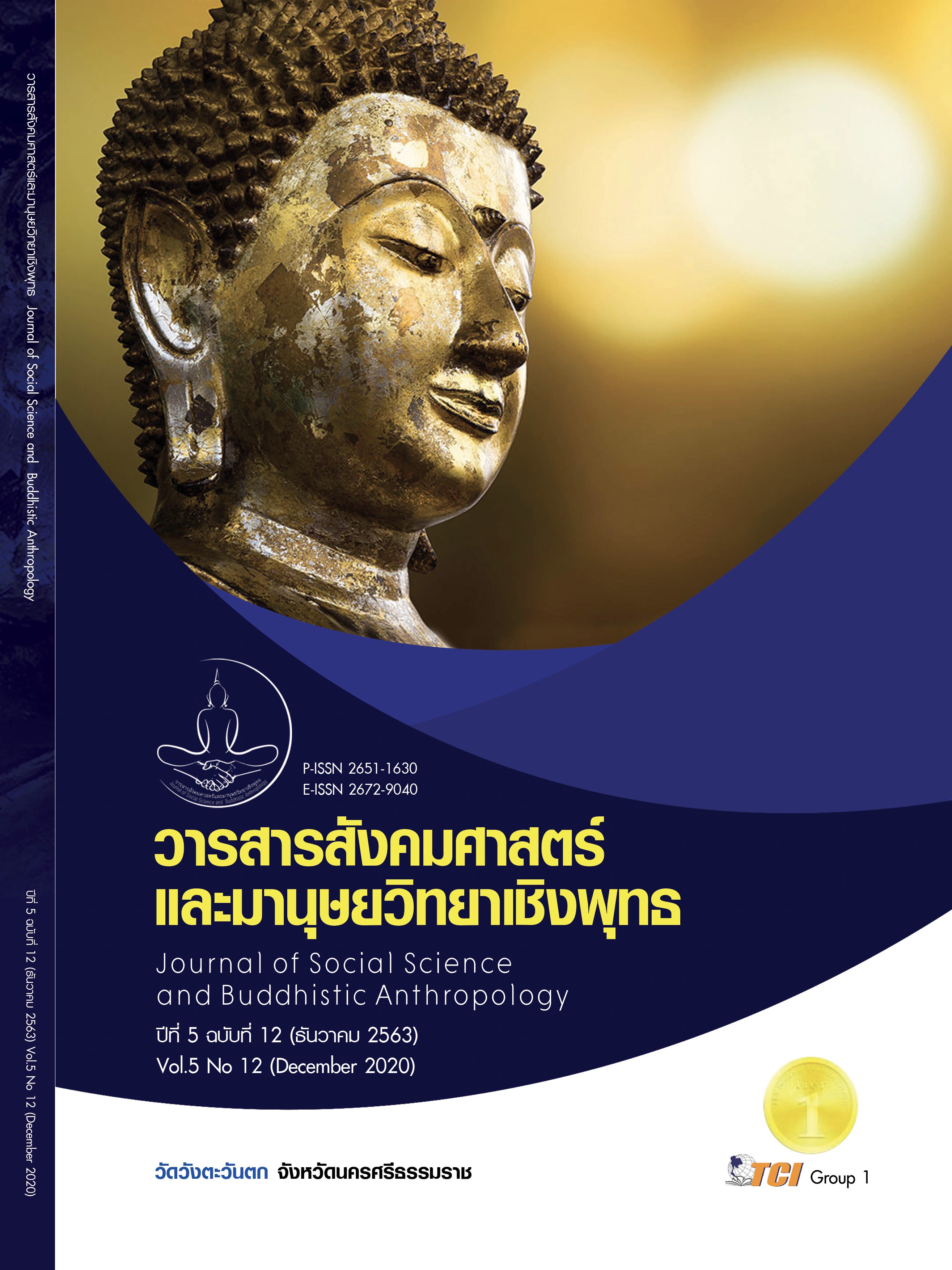RELATIONSHIP STRUCTURE OF THE ENTREPRENEURIAL FOCUS GOVERNMENT SUPPORT AND INNOVATIVE PERFORMANCE THAT INFLUENCED THE COMPETITIVE ADVANTAGE OF OTOP BUSINESS IN THE NORTHERN REGION OF THAILAND
Keywords:
Focusing on Entrepreneurship, Government Support, Innovative Performance, Competitive Advantage for OTOP BusinessAbstract
The objectives of this research artical were to 1) study the importance of focusing on entrepreneurship, government support, innovation performance, and competitive advantage 2) analyze the relationship structure of the entrepreneurial focus, government support, and innovative performance that influenced the competitive advantage of OTOP business in the northern region of Thailand. The samples were the only manufacturer or the president of the community enterprise group or secretary of clothes and clothing in the upper northern region of Thailand, SMEs, for 500 peoples. It was a quantitative by using questionnaires as a tool. Data were analyzed by using descriptive statistics to find the frequency, percentage, and standard deviation. Inference statistics for relationship analysis used structural equations with AMOS program. The result of the research showed that 1)Entrepreneurship, innovation performance, and competitive advantage had high level of importance and government support had medium level of importance. 2)The results of the analysis of causal relationships using structural equations were found that the emphasis on entrepreneurship had the most direct influence on government support, followed by government support with direct influence on innovative performance. Government support had a direct influence on the competitive advantage. The focus on entrepreneurship had a direct influence on the competitive advantage. Government support had a direct influence on the competitive advantage, and finally, the innovative performance had a direct influence on the competitive advantage. The results of quantitative that is a form of competitive advantage based on the focus on entrepreneurship and indirect factors that are the government support and Innovative Performance.
References
กรมการพัฒนาชุมชน. (2562). รวมผลการจำหน่ายสินค้าหนึ่งตำบล หนึ่งผลิตภัณฑ์. เรียกใช้เมื่อ 30 กันยายน 2562 จาก http://logi.cdd.go.th/cddcenter/cdd_report /otop_r04.php
กระทรวงวัฒนธรรม. (2562). ศูนย์ข้อมูลวัฒนธรรม: การแต่งกาย. เรียกใช้เมื่อ 10 กันยายน 2562 จาก https://digital.m-culture.go.th/list.html?type=dress
สำนักงานพัฒนาเศรษฐกิจและสังคมแห่งชาติ. (2560). 6-6-4 ยุทธศาสตร์ชาติกับแผนฯ 12. วารสารเศรษฐกิจและสังคม, 54(1), 1-68.
Aykan E., et al. (2013). Effects of support programs on corporate strategies of small and medium-sized enterprises. Procedia - Social and Behavioral Sciences, 99(2013), 938-946.
Barney, J. (2001). The Resource-Based View of the Firm: Ten Years After 1991. Academic of Management Review, 2(1), 41-56.
Boso, N. et al. (2013). Entrepreneurial Orientation, Market Orientation, Network Ties, and Performance: Study of Entrepreneurial Firms in a Developing Economy. Journal of Business Venturing, 28(6), 708-727.
Comrey, A. L. & Lee, H. B. (1992). A first course in factor analysis (2nd ed.). Lawrence Erlbaum Associates: Inc.
Gopalakrishnan, S. & Damanpour, F. (1997). A Review of Innovation Research in Economics Sociology and Technology Management. International Journal of Management Science, 25(1), 15-28.
Grant, R. M. (1991). The Resource-Based Theory of Competitive Advantage: Implications implications for strategy formulation. California Management Review, 33(3), 114-135.
Kasornbua, T. (2013). The Competency Development Of One Tambon One Product (OTOP) Community Enterprise To Small And Medium Enterprises (SMES): A Case Study Of Processed Banana Food Products Community Enterprise. Modern Management Journal, 11(2), 74-86.
Koomsalud, et al. (2019). To Study New Product Development Process of the Entrepreneurs in the One Tumbon One Product (OTOP) Project Based on the Concept of the One Village One Product (OVOP). Panyapiwat Journal, 9(3), 16-28.
Likert, R. N. (1970). A technique for the measurement of attitude. Chicago: Ronal McNally & Company.
Maritz, A. (2015). Senior Entrepreneurship In Australia: Anexploratory Approach. The International Journal of Organizational Innovation, 7(3), 6-23.
Meksuwan, A. et al. (2017). Effect of Intellectual Capital, Marketing Capability, Participation toward Business Performance of Hand-Woven Cloth Community Enterprises in Upper Northern Region of Thailand. Journal of Graduate Studies in Northern Rajabhat Universities, 6(11), 111-124.
Porter, M. E. (1980). Competitive Strategy: Techniques for Analysis Industries and Competitors. New York: Free Press.
Porter, M. E. (2005). The Competitive Advantage Creating and Sustaining Superior Performance. New York: Free Press.
Ronstadt, R. (1998). “Ex-cntrcprcheus and the Decisjon to Start an Entreprencurial Carcer.” In J. Hornaday et al. (eds.), Frontiers of Entrepreneurship Research. Wellsley, MA: Babson College.
Schilling, M. A. (2008). Strategic management of technological innovation (2nd ed.). New York: McGraw-Hill Education.
Schumpeter, J. A. (1965). Economic Theory and Entrepreneurial History. In Aitken HG (ed) Explorations in enterprise. Harvard University Press, Cambridge, MA.
Tidd, J. & Bessant, J. (2009). Managing Innovation: Integrating Technological, Market And Organizational Change. Retrieved September 30, 2019, from https://www.researchgate.net/publication/228315617
Tirakanan, S. (2010). Analysis on the Multiple Variables in the Social Science Researches. Bangkok: Chulalongkorn University.
Utterback, M. & Abernathy, J. (1975). A Dynamic Model of Process and Product Innovation. Omega, 3(6),639-656.
Wingwon, B. (2016). Strategic Entrepreneurship. Bangkok: Ramkhamhaeng University.
Zeebaree, M. R. Y. & Siron, R. B. (2017). The Impact of Entrepreneurial Orientation on Competitive Advantage Moderated by Financing Support in SMEs. International Review of Management and Marketing, 7(1), 3-52.
Zehir, C. & Karaboga, T. (2015). Linking Entrepreneurial Orientation to Firm Performance: The Role of Differentiation Strategy and Innovation Performance. Procedia-Social and Behavioral Sciences, 210(December 2015), 358-367.








